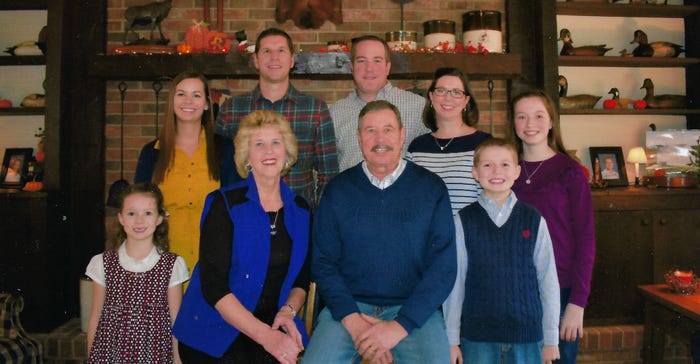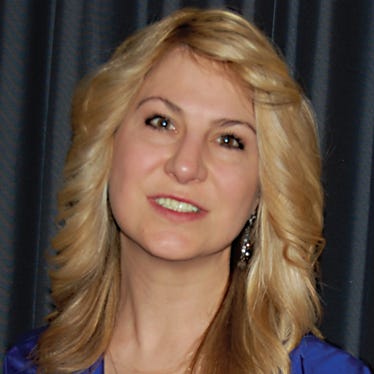
COMMITTED TO CONSERVATION: Paul and Joanne Mechling's family is being recognized with a 2018 Ohio Conservation Farm Family Award. The family includes their granddaughter Claire Loveland, 7, (front left), Joanne, Paul, grandson Luke Loveland, 10, daughter-in-law Beth Mechling (back left), son Noah, son-in-law Marc Loveland, daughter Sarah Loveland and granddaughter Madison Loveland, 12.
On a Gator ride through the winding trails on Snowy Oak Tree Farm, owner Paul Mechling kicks up a couple of deer. Just down the lane, along the tree line, four wild turkeys are taking an afternoon stroll. It makes Paul’s heart happy.
This Ashtabula tree farmer is also a conservationist in every sense of the word, managing wildlife habitat, land, trees and water, while combating invasive and destructive plant and pest species. The farm, which also produces maple syrup, has been used extensively to demonstrate conservation to the public, and Paul is a vocal advocate for conservation practices, serving on many different conservation and wildlife boards. He is being recognized with a 2018 Ohio Conservation Farm Family Award.
Paul was raised on a farm, and he’s quick to note that both sets of parents and grandparents were conservation-minded with strong land ethics, which prompted him to pursue conservation projects in 4-H and FFA.
He also had another love, though — animals. That interest steered him to become a veterinarian for more than 38 years. His conservation interest never waned, though — it overlapped. Now that he’s been retired for six years, it’s much of his focus — as well as family, which now includes three beloved grandchildren.
"Our responsibility is to continue this land ethic in our children and grandchildren through conservation education and action," says Paul, quoting renowned conservationalist Aldo Leopold. "Conservation occurs when we have harmony between man and land."
Getting started
Paul met his wife of 46 years, Joanne, in church while in his freshman year at Ohio State University. She was a family and consumer science teacher for 35 years, and is now retired, too. Together in 1974, they purchased the original 30 acres of the farm in Ohio’s most northeastern county, just a mile from the Pennsylvania border.
Neither of them are originally from the area. He grew up in Lancaster while she was a native of the Toledo area. They soon realized how harsh the winters could be, and how the hardpan in the soil made it difficult to grow crops.
"This is the coldest, wettest, snowiest part of Ohio," he says. "The weather service says our 40-year average is 130 inches of snow annually, and this year we had snow until April 21."
It was, however, well suited for trees. Paul got to planting trees. Today, the farm has grown to 365 acres, and he’s planted over 140,000 trees on mostly reverting agricultural fields. About 15,000 of them are oak trees protected with plastic, white tubes until their trunk fills the diameter.
"At first, I was busy with my vet business, so we didn’t buy more land until 1997," Paul says. "Since that time, we’ve added 13 parcels, anywhere from 5 acres to 62 acres, and 298 acres of them are contiguous.
On the right track
In 1978 a management plan was developed by a certified forester, and Snowy Oak Tree Farm has since been a certified tree farm through the American Forest Foundation, which inspects the woodlands every five years to ensure sustainable forestry.
Paul practices grapevine control, invasive species control and woodland road maintenance with water bars, culverts and gravel stream crossings. For woodland improvement, he uses crop tree release. "It’s like weeding your garden," he explains. "I’m picking the good trees, and eliminating the others."
The woods are comprised of both hardwood (including six different kinds of oak, cherry, black walnut and more) and conifers, including white, black and Norway spruce, white pine, hemlock, larch, and bald cypress.
The maples were first tapped in 1996, as sort of a hobby for their son, Noah. Today, the family taps 3,000 trees and boils sap from another 1,500 trees from neighbors’ properties. "The income from maple syrup (about 18,000 gallons since the beginning) goes back into our tree farm for conservation projects," Paul says.
The arrival of the Emerald Ash Borer has meant that about 135 of the larger white ash trees needed to be cut for lumber. Some dead trees were left for wildlife habitat.
Also for wildlife, two areas of about 6 acres has been established with pollinator habitat. Warm-season grasses have been planted in three areas comprising 9 acres, where prescribed burns are applied. Five acres of sunflowers and other grains and legumes serve as food plots for wildlife.
A pond was added in 1976, and three more have since been added. Paul has cooperated with the Ohio Division of Wildlife to build three wetlands with more than 11 acres of wetlands protected permanently through the Wetland Reserve Program.
Even with all the progress, the work is in the early stages, he says. "We’re many years out because on a lot of the land we’ve purchased, previous owners left ruts and cut the best trees and left the junk."
Still, he has a vision and enjoys the work. "I get a lot of personal satisfaction," he says, noting that forests help clean the air and water, sequester carbon, provide aesthetics and a calming effect, and provide recreation, wood products and syrup.
"Our kids and grandkids are socially aware of the benefits of conservation and have an appreciation for it," Paul says. "They have a lot of responsibility coming on here soon, but we’ve trained them to be ready for that — that’s really important."
More on Paul and Joanne Mechling
• The family: Paul and Joanne are the parents of two grown children: son Noah Mechling and his wife, Beth; and daughter Sarah and her husband, Marc Loveland, who are the parents of Madison, 12, Luke, 10, and Claire, 7.
• The farm: Snowy Oak Tree Farm in Ashtabula County consists of 365 acres, with 305 being in woodlands. The rest is divided between nine acres of warm season grasses, eight acres of pollinator habitat, 12 acres of wetlands/ponds, five acres of food plots and six acres of roads and lanes.
• Nominated by: Nathan Paskey, manager, Ashtabula Soil and Water Conservation District.
• Conservation outreach: The farm has been used by the local high school for Envirothon training, Boy Scout tree planting for forestry badges and FFA tree planting projects. It was also used to mentor northern Ohio tree farmers to the Ohio Tree Farm System. The Ashtabula County Commissioners have toured the farm’s wetlands to see the benefits of the east branch of the Ashtabula River, which is an Ohio Scenic River. The Ashtabula County Leadership Class annually tours the woods and sugar house to learn the economic benefits of forestry, conservation and maple syrup for the county. State Rep. John Patterson tours the farm regularly and consults with Paul on forestry, wildlife, conservation and maple syrup issues.
• Community leadership: Paul is a member of the Good Shepherd Lutheran Church. At the county level, Paul is or has been a member of the Health Board, Scenic River Advisory Council, Soil and Water Conservation District Board of Supervisors (since 1998 and holding all offices). He is also a member of the Ohio Maple Producers, Ohio Tree Farm Committee (past chairman), Ohio Wildlife Council (current chair), Ohio Forestry Advisory Council, American Forestry Foundation Public Affairs Committee, Solutions from the Land (Ohio Smart Agriculture — Climate Committee).
About the Author(s)
You May Also Like






